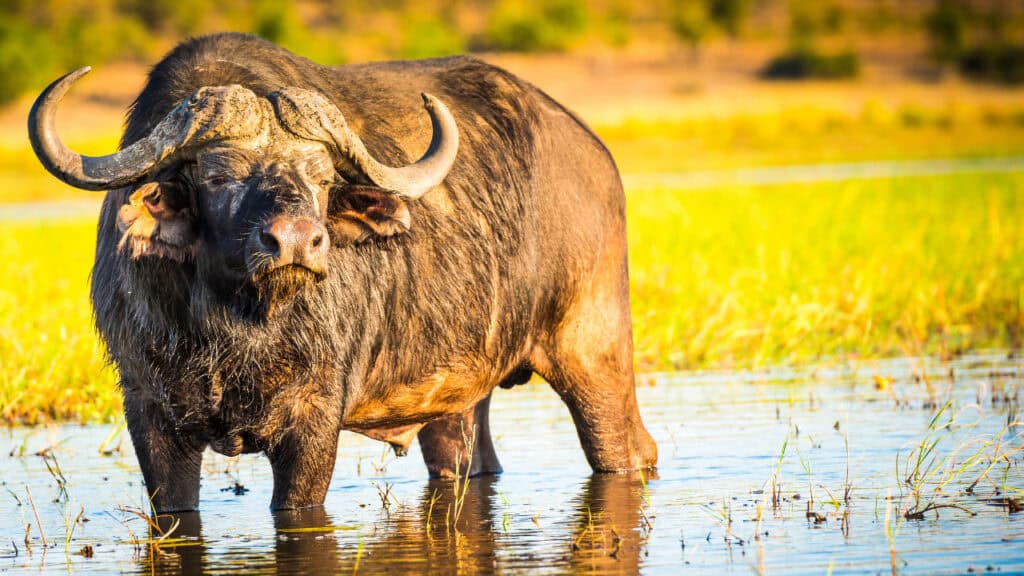Chobe National Park is a year-round safari destination, but the best time to visit can depend on what you want to experience. Each season offers unique opportunities to explore the park’s diverse landscapes and abundant wildlife.
Best Time to Visit

The best time to visit Chobe National Park for a safari is during the dry season, which runs from May to October. During this period, the weather is cooler and wildlife congregates around water sources, making it easier to spot animals.
Month-by-Month Guide
January – March: Wet Season
- Weather: Hot and wet, with afternoon thunderstorms. Average temperatures range from 20°C (68°F) at night to 30°C (86°F) during the day.
- Rainfall: High, with monthly averages of about 150-200mm (5.9-7.9 inches).
- Winds: Generally light but can increase during thunderstorms.
- Wildlife Viewing: Wildlife can be harder to spot due to dense vegetation, but bird watching is exceptional with migratory species present.
- Highlights: Lower rates and fewer tourists offer a more exclusive experience. This is also a great time for photographers due to the vibrant, green landscapes.
April – May: Transition Period
- Weather: The rains begin to subside, with temperatures ranging from 18°C (64°F) to 28°C (82°F).
- Rainfall: Decreasing, with monthly averages of about 50-100mm (2-3.9 inches).
- Winds: Light and variable.
- Wildlife Viewing: Increasingly good wildlife sightings as animals begin to gather around remaining water sources.
- Highlights: Clear skies and fewer tourists, making for a more intimate safari experience.
June – August: Long Dry Season
- Weather: Cool and dry, with clear skies. Average temperatures range from 10°C (50°F) at night to 27°C (81°F) during the day.
- Rainfall: Minimal, with monthly averages of about 0-10mm (0-0.4 inches).
- Winds: Light and steady, making for pleasant game drives and boat safaris.
- Wildlife Viewing: Peak season for game viewing as animals congregate around waterholes and the Chobe River.
- Highlights: Ideal for boat safaris on the Chobe River and game drives. This is the best time to see large herds of elephants.
September – October: Peak Wildlife Viewing
- Weather: Hot and dry, with temperatures ranging from 20°C (68°F) to 35°C (95°F).
- Rainfall: Very low, with monthly averages of about 0-10mm (0-0.4 inches).
- Winds: Light and variable.
- Wildlife Viewing: Peak game viewing as animals are highly concentrated around limited water sources.
- Highlights: Excellent for photographic safaris due to clear skies and abundant wildlife. The Chobe River is a hub of activity with animals coming to drink.
November – December: Start of Wet Season
- Weather: Hot with the onset of rains. Afternoon thunderstorms are common. Temperatures range from 22°C (72°F) to 32°C (90°F).
- Rainfall: Increasing, with monthly averages of about 50-150mm (2-5.9 inches).
- Winds: Light, with occasional gusts during thunderstorms.
- Wildlife Viewing: Wildlife is still good, but animals begin to disperse as water becomes more available.
- Highlights: The landscape turns green, and birdlife is abundant. Fewer tourists make for a more peaceful safari experience.
By Activity

- Game Viewing: Best from June to October when wildlife congregates around water sources.
- Bird Watching: Best from November to April when migratory birds are present.
- Boat Safaris: Best during the dry season from May to October when animals are concentrated around the Chobe River.
- Photographic Safaris: Best from June to October for clear skies and optimal wildlife viewing conditions.
Climate Overview
Chobe National Park’s climate is generally warm and temperate. The park experiences two main seasons: the dry season and the wet season.
- Dry Season (May to October): Characterized by cooler temperatures and minimal rainfall. Ideal for wildlife viewing as animals gather around water sources. Average temperatures range from 10°C (50°F) at night to 27°C (81°F) during the day.
- Wet Season (November to April): Hot and wet, with frequent thunderstorms. The landscape is lush and green, offering different wildlife experiences and excellent bird watching opportunities. Average temperatures range from 20°C (68°F) at night to 32°C (90°F) during the day.
No matter when you choose to visit Chobe National Park, you’re guaranteed a memorable safari experience. Each season brings its own unique charm and opportunities for adventure.
Plan your trip according to your interests and enjoy the best that Chobe has to offer year-round. Set off on a journey to Chobe National Park and uncover a destination brimming with adventure, beauty, and unforgettable memories.